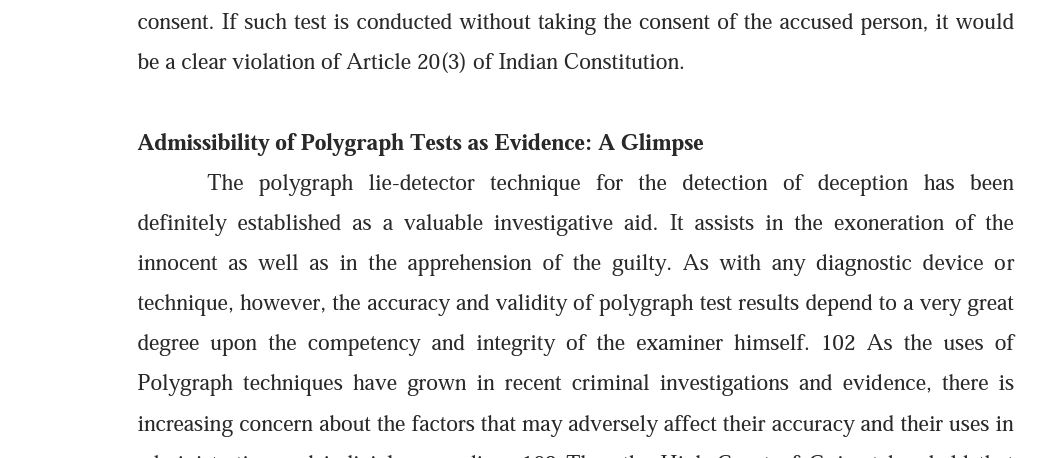During the Polygraph test an expert and skilled examiner will make assessment of the following procedure –
- a) An assessment of examiner‘s emotional state;
- b) Medical fitness of the examinee;
- c) To identify overly responsive behaviour specialised tests be conducted;
- d) To assess overly responsive behaviour specialised test be conducted ;
- e) To do factual analysis of case information and
- f) To do pre-test interview and detail review of question.
In Polygraph process three aspects of human physiology are tested i.e.
a) Pneumograph tracing
b) Elect o dermal activity tracing, and
c) Cardiovascular tracing.
The first relate to respiration, the second to skin conductor or skin resistance and the third with blood volume and pulse rate.39 When an individual undertakes a Poly graphic lie detection test, the first phase of this usually involves an interview with the Polygrapher during which some biographical question will be asked or job application the 13 “Chapter VI Polygraph Test and its Legal Implication in the Indian ….”
International Journal of Pure and Applied Mathematics Special Issue actual nature of the question which will be asked during the lie detection test. It will be asked by the Polygrapher to the individual whether the individual understand every question .Many Polygraphers also use this first phase to obtain an initial impression of the testee and to judge whether the individual seems to be more of an honest, upright citizen than a deceiver. At this time, the Polygrapher will not have been switched on, but now the Polygrapher will explain its basic principle .He or she will connect the individual to the machine and show the testee how it work.40 The second phase begins when the suspect is asked a series of question to which the reply of either ‗no or ‗yes‘ must be given. The Polygraph is switched on and now is out of sight of testee, usually behind him or her. During this phase, the various psychologically activity which may accompany the testee‗s answer to the question is displayed and recorded on pen chart .The basic principle underlying modern Polygraph is that of making a comparison between how a person respond to non-incriminating question and how he or she respond to incriminating question. This comparison does not look for any complex pattern of responding (for example, high heart rate and also low respiration rate when lying, and the reverse when telling the truth, but at magnitude and frequency of psychological activity to various sort of question. In relevant questioning techniques ,several irrelevant questions are framed which have no basing on the case or involvement of the subject in a crime under investigation .The relevant question are interposed in-between irrelevant question ,which have a direct bearing on the case ,and are likely to draw stressed response from a quality subject. The typical relevant irrelevant test employ a series of 10-15 question comprised of crime relevant questions (e.g., ―did you rob Mr. H.C. Gupta‖) and irrelevant (neutral) question (e.g., ―Are you sitting down‖). The rational of the RT predicts that the since a guilty subject will answer the relevant question deceptively, it is expected that the guilty person will exhibit relatively strong physiological reaction to the relevant as compared to the truthfully answered irrelevant question. Conversely, the rational of the RTI predicts that since an innocent subject will answer all questions truthfully, it is expected that there will be little difference in the strength of reaction to the two types of questions. 1
